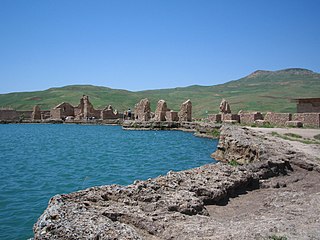
Islamic architecture comprises the architectural styles of buildings associated with Islam. It encompasses both secular and religious styles from the early history of Islam to the present day. The Islamic world encompasses a wide geographic area historically ranging from western Africa and Europe to eastern Asia. Certain commonalities are shared by Islamic architectural styles across all these regions, but over time different regions developed their own styles according to local materials and techniques, local dynasties and patrons, different regional centers of artistic production, and sometimes different religious affiliations.

The Hammadid dynasty was a branch of the Sanhaja Berber dynasty that ruled an area roughly corresponding to north-eastern modern Algeria between 1008 and 1152. The state reached its peak under Nasir ibn Alnas during which it was briefly the most important state in Northwest Africa. Its realm was conquered by the Almohad Caliphate.

Takht-e Soleymān, is an archaeological site in West Azerbaijan, Iran dating back to Sasanian Empire. It lies midway between Urmia and Hamadan, very near the present-day town of Takab, and 400 km (250 mi) west of Tehran.

The Ben Youssef Madrasa is an Islamic madrasa (college) in Marrakesh, Morocco. Functioning today as a historical site, the Ben Youssef Madrasa was the largest Islamic college in the Maghreb at its height. The madrasa is named after the adjacent Ben Youssef Mosque built by the Almoravid Sultan Ali ibn Yusuf in the early 12th century. The madrasa building which stands today was commissioned by the Sa'di sultan Abdallah al-Ghalib in the 16th century, following a style established during the earlier Marinid period.

Moroccan architecture reflects Morocco's diverse geography and long history, marked by successive waves of settlers through both migration and military conquest. This architectural heritage includes ancient Roman sites, historic Islamic architecture, local vernacular architecture, 20th-century French colonial architecture, and modern architecture.

Qal'at Bani Hammad, also known as Qal'a Bani Hammad or Qal'at of the Beni Hammad, is a fortified palatine city in Algeria. Now in ruins, in the 11th century, it served as the first capital of the Hammadid dynasty. It is in the Hodna Mountains northeast of M'Sila, at an elevation of 1,418 metres (4,652 ft), and receives abundant water from the surrounding mountains. The site is near the town of Maadid, about 225 kilometres (140 mi) southeast of Algiers, in the Maghreb.

Moorish architecture is a style within Islamic architecture which developed in the western Islamic world, including al-Andalus and what is now Morocco, Algeria, and Tunisia. Scholarly references on Islamic architecture often refer to this architectural tradition by a more geographic designation, such as architecture of the Islamic West or architecture of the Western Islamic lands. The use of the term "Moorish" comes from the historical Western European designation of the Muslim inhabitants of these regions as "Moors". Some references on Islamic art and architecture consider this term to be outdated or contested.

Stucco decoration in Islamic architecture refers to carved or molded stucco and plaster. The terms "stucco" and "plaster" are used almost interchangeably in this context to denote most types of stucco or plaster decoration with slightly varying compositions. This decoration was mainly used to cover walls and surfaces and the main motifs were those predominant in Islamic art: geometric, arabesque, and calligraphic, as well as three-dimensional muqarnas. Plaster of gypsum composition was extremely important in Islamic architectural decoration as the relatively dry climate throughout much of the Islamic world made it easy to use this cheap and versatile material in a variety of spaces.

Islamic geometric patterns are one of the major forms of Islamic ornament, which tends to avoid using figurative images, as it is forbidden to create a representation of an important Islamic figure according to many holy scriptures.
The Arab-Ata Mausoleum is a cubical, domed brick mausoleum built in 977-78 in the village of Tim, Samarqand Region, Uzbekistan. Built during the Samanid Empire, the Arab-Ata Mausoleum was among the earliest buildings to include three notable features of Islamic architecture: the muqarnas, mihrab, and pishtaq. Following the appearance of the mihrab in the Arab-Ata mausoleum, mihrabs became a more common feature in mausoleums from the tenth century on. The Arab-Ata is the earliest dated example of a pishtaq, with it becoming a staple of Islamic architecture. It has been proposed that the pishtaq developed further with the many Seljuq domes from the eleventh and twelfth centuries.

Muqarnas, also known in Iberian architecture as Mocárabe, is a form of ornamented vaulting in Islamic architecture. It is the archetypal form of Islamic architecture, integral to the vernacular of Islamic buildings. It was most likely first developed in eleventh-century Iraq, though the earliest preserved examples are also found outside this region.

Seljuk architecture comprises the building traditions that developed under the Seljuk dynasty, when it ruled most of the Middle East and Anatolia during the 11th to 13th centuries. The Great Seljuk Empire contributed significantly to the architecture of Iran and surrounding regions, introducing innovations such as the symmetrical four-iwan layout and the first widespread creation of state-sponsored madrasas. Their buildings were generally constructed in brick, with decoration created using brickwork, tiles, and carved stucco.

Mamluk architecture was the architectural style that developed under the Mamluk Sultanate (1250–1517), which ruled over Egypt, the Levant, and the Hijaz from their capital, Cairo. Despite their often tumultuous internal politics, the Mamluk sultans were prolific patrons of architecture and contributed enormously to the fabric of historic Cairo. The Mamluk period, particularly in the 14th century, oversaw the peak of Cairo's power and prosperity. Their architecture also appears in cities such as Damascus, Jerusalem, Aleppo, Tripoli, and Medina.

Gülru Necipoğlu is a Turkish American professor of Islamic Art/Architecture. She has been the Aga Khan Professor and Director of the Aga Khan Program for Islamic Architecture at Harvard University since 1993, where she started teaching as Assistant Professor in 1987. She received her Harvard Ph.D. in the Department of History of Art and Architecture (1986), her BA in Art History at Wesleyan, her high school degree in Robert College, Istanbul (1975). She is married to the Ottoman historian and Harvard University professor Cemal Kafadar. Her sister is the historian Nevra Necipoğlu.

The Zumurrud Khatun Mosque and Mausoleum, also known as the Tomb of Sitta Zubayda, is a historic mosque and shrine located in Baghdad, Iraq. It dates back to the Abbasid era. It is located in Sheikh Maarouf Cemetery in the Karkh side of Baghdad, and the site was built at the patronage of Zumurrud Khatun and her son. Zumurrud Khatun was mother of the 34th Abbasid Caliph Al-Nasir, and wife of the 33rd Abbasid Caliph Al-Mustadi. She collected the waqf money from madrasas and built her mausoleum before her death, which is located in Karkh.

Yvonne Dold-Samplonius was a Dutch mathematician and historian who specialized in the history of Islamic mathematics during the Middle age. She was particularly interested in the mathematical methods used by Islamic architects and builders of the Middle Ages for measurements of volumes and measurements of religious buildings or in the design of muqarnas.

The Sinan Pasha Mosque is a mosque in the Bulaq district in Cairo. It was established by the governor of Cairo Koca Sinan Pasha around 1571.

The lambrequin arch, also known as the muqarnas arch, is a type of arch with an ornate profile of lobes and points. It is especially characteristic of Moorish and Moroccan architecture.
Al-Sayyida al-Mu'iziyya, mainly known as Durzan, was the main consort of Fatimid Caliph al-Muizz and the mother of the Fatimid imam-caliph al-Aziz. She was known as the first patroness of Fatimid architecture. Durzān also founded the second great Fățimid mosque of Cairo, a congregational mosque located in the Qarafa.

Almoravid architecture corresponds to a period from the 11th to 12th centuries when the Almoravids ruled over the western Maghreb and al-Andalus. It was an important phase in the development of a regional Moorish architecture, as the styles and craftsmanship of al-Andalus were further imported and developed in North Africa. The Almoravids founded the city of Marrakesh as their capital and built many mosques in the region, although much of what they built has not preserved. The Almoravids were overthrown by the Almohads in the 12th century, after which Almohad architecture continued to develop some of the same trends in the Maghreb and al-Andalus.

















